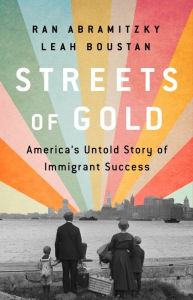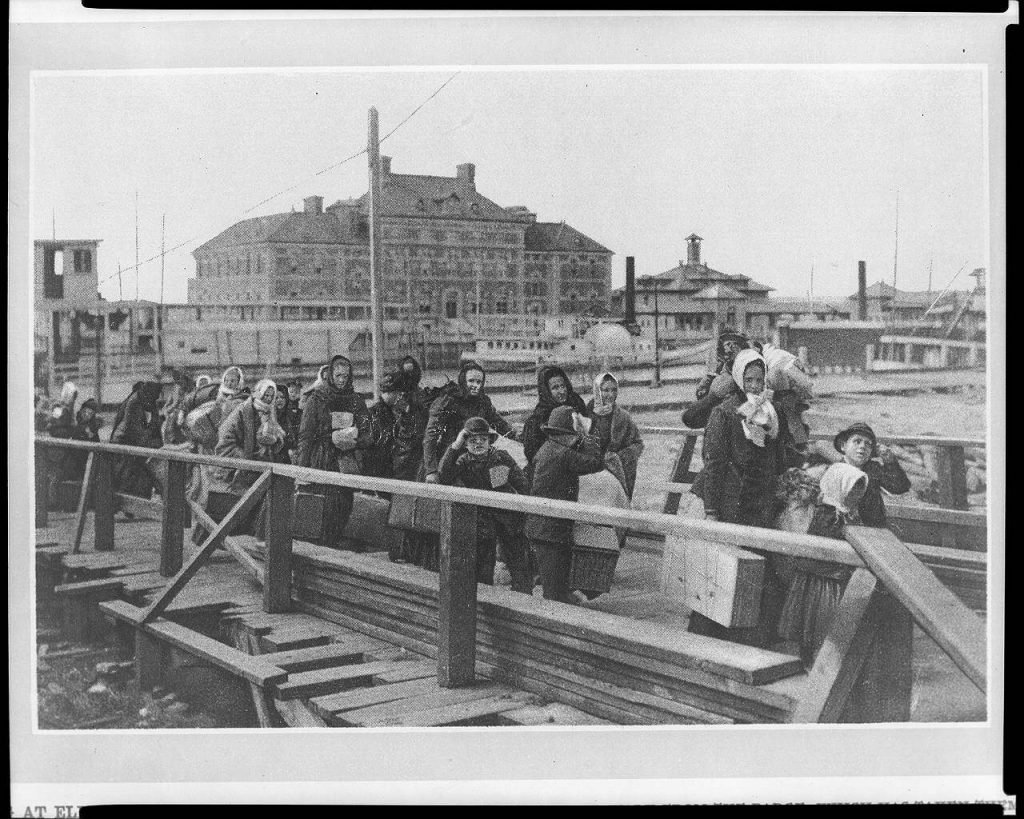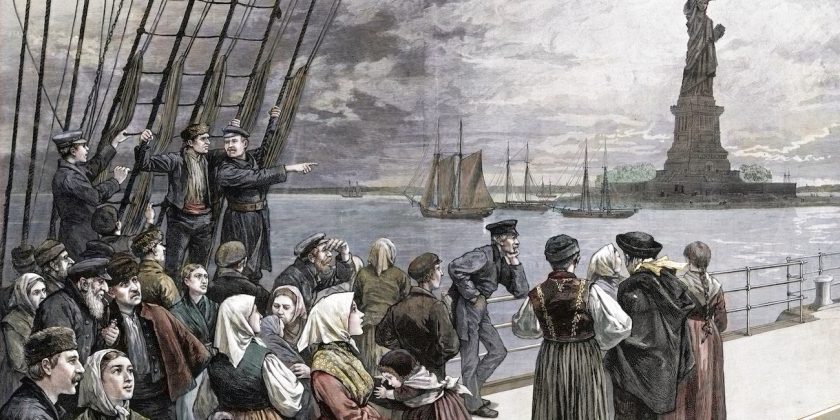In their new book Streets of Gold: America’s Untold Story of Immigrant Success, Ran Abramitzky and Leah Boustan write: “For every uplifting tale of an immigrant striking it rich, there is an ominous story of an immigrant undermining American culture from within. For many Americans, ideas about immigration are based on these tales and the feelings they arouse, not on facts and data. It’s no wonder immigration is one of those divisive issues that everyone thinks they understand. Ultimately, immigration myths color how voters think about immigration and affect immigration policy.”
The book goes on to dispel these myths, using mountains of historical census data to show how immigrants have risen to success over generations, and how today’s immigrants have more in common with those of the Ellis Island era than many assume.
Here, IPL faculty co-director David Laitin explores the book with Ran Abramitzky, a Stanford economist and IPL faculty affiliate.
 David Laitin: Ran, before we get into the meat of your findings, let me stress how enjoyable it was to read your book. It is often said that the word data is the plural of anecdote. You pepper your book with so many memorable anecdotes that illuminate your themes, starting with the epigraph—the source of your book title—graffiti painted on the wall of the Ellis Island Museum. It quotes an unknown immigrant who says, “I came to America because I heard the streets were paved with gold. When I got here, I found out three things: First, the streets weren’t paved with gold; second, they weren’t paved at all; and third, I was expected to pave them.” I couldn’t wait to turn the page.
David Laitin: Ran, before we get into the meat of your findings, let me stress how enjoyable it was to read your book. It is often said that the word data is the plural of anecdote. You pepper your book with so many memorable anecdotes that illuminate your themes, starting with the epigraph—the source of your book title—graffiti painted on the wall of the Ellis Island Museum. It quotes an unknown immigrant who says, “I came to America because I heard the streets were paved with gold. When I got here, I found out three things: First, the streets weren’t paved with gold; second, they weren’t paved at all; and third, I was expected to pave them.” I couldn’t wait to turn the page.
Perhaps you can share a few more of them with us and also tell us how you compiled data on the stories of millions of immigrant families.
Ran Abramitzky: Thank you, David. We tell the stories of many immigrant families, past and present, that bring the data to life. We introduce immigrants who passed through Ellis Island from various European countries, as well as the journeys of Asian and Mexican immigrants who came to the country more recently. We tell our own family stories and those of colleagues like Tino Cuéllar, who was a justice of the Supreme Court of California and whose grandfather was a shepherd in Mexico. The stories illustrate the main patterns we find in the data.
The immigrant experience is more of a novel than a short story. It begins with the departure from a poor home country, which improves the immigrant’s prospects dramatically. In the second chapter, immigrants often struggle to make their way in the new country. But in the third chapter, their children become quite successful in the United States.
The stories also convey how we worked with big data. Think of us as curious grandchildren searching for their grandparents in old historical records—then multiply that inquiry by millions. In the US Census data, we can see where people lived, who they married, what they named their children, and what they did for a living. We can then analyze all the data and see how much of what we know about immigration is based in myth rather than in fact. Is it really true that immigrants generally start off poor but climb the economic ladder within their own lifetime? How do immigrants of the past compare to immigrants today?
DL: You find that, despite the hope of migrants in the 19th century to find in America “streets of gold,” in fact the first generation suffered economically. Why was it so hard?
RA: We often hear that immigrants in the past went from rags to riches, and that tends to be contrasted with today’s immigrants, who are assumed to be lagging behind. We find that the “rags to riches” idea is largely a myth. Many of the immigrants who passed through Ellis Island were slow to climb the economic ladder, working many odd jobs and never making it into the white collar professions. Like today, immigrants working in lower-paying occupations tend to lag behind American workers for the rest of their lives. At the same time, we find that many other immigrants started with high-paying jobs when they first came to the United States. So how did the “rags to riches” myth come about? Partly through family lore, the older generation telling the younger: “We came here with nothing, but we worked hard and were able to rise from poverty to comfort.”
The myth persisted because for many years we didn’t have the right data to check the facts. The data scholars did have in the past led them to wrongly conclude many people were going from poverty to riches. If they were looking at the 1970 cross section of data, they get a snapshot of the U.S. economy, and they notice that immigrants who have been here for five years are struggling, but those who have been here for thirty years are doing very well. So they thought that immigrants might follow a pattern of working below the native born but catching up and even surpassing them. But at that time, an immigrant in the recent arrivals group was likely to be from Mexico, and they’d be comparing him to a German scientist who had arrived 35 years before.
With the panel data we created, we can follow the same immigrant over time. Here we find that immigrants do make progress, but at a much slower pace than before. And these immigrants knew that the streets were not paved with gold but that they had to pave the way for their own success.
DL: You also find that the second generation of immigrants who came in the 19th century performed economically better than children of natives from the same generation. Why did they outperform the already integrated Americans?
RA: As you say, we find that children of immigrants are very upwardly mobile. For nearly every sending country we looked at, the children largely catch up with the children of people born in the United States. When we do a more “apples to apples” comparison, looking just at children of poor immigrants—those who grew up at the 25th percentile of the income distribution—we find that they do better than children of the U.S. born who grew up equally poor. This pattern holds true for immigrants of nearly every sending country.
To explain this, we thought first of education. But in the past, immigrant parents actually did not invest more in their children’s education than U.S.-born parents. If anything, immigrants’ children were less likely to stay in school than their counterparts at the same point in the income distribution.
Much of the reason, it turns out, is in location choice. Immigrants tended to move to locations in the United States that offered the best opportunities for their children’s upward mobility. The U.S. born were more rooted in place. Historically, for example, immigrants were unlikely to move to the U.S. south, which was a region of low upward mobility for everyone. So why didn’t native-born Americans in the past move to places offering economic opportunity? Back then, people were more likely to live in the same place their parents and grandparents were from, and with friends and networks tying them to that place, they weren’t thinking just of economic returns. But an immigrant had already made the decision to leave home—you’re already more footloose than the U.S. born, so you may as well move to a place with greater opportunity for you and your children.

DL: That was one of the most surprising findings in the book. I thought the immigrant parents who were having trouble would be more dictatorial than the native-born parents, forcing their kids to study every hour.
RA: In the modern data, we also see that immigrants prefer to live in places like New York, San Francisco, and Providence that offer greater opportunity for everyone. But we can’t tell as much about how much parents invest in their children’s education because we don’t have the individual-level underlying data. I suspect that, with the increase in the returns to education, it’s more important than it was back then. But yes, I was surprised that immigrants’ children were not better educated.
DL: One of your more stunning findings is that the pattern of economic integration of the immigrants and their children in the late 20th century (now, mostly from South America) has been almost precisely the same as the 19th century immigrants. How do you know this? And why do so many Americans have the wrong impression of this?
RA: We find striking similarities between past and present in many dimensions. For example, it also is true today that children of immigrants are more upwardly mobile than those who grew up in economically similar households with U.S.-born parents. And this is true of almost every sending country today, including poorer ones like El Salvador, Mexico, and Laos, just as it held across the sending countries of the past. Today, children whose parents came from Mexico or the Dominican Republic are just as likely to move up from their parents’ circumstances as were children of poor Danes and Swedes one hundred years ago.
How do we know this? To compare children from these two sets of low-income families, we first need data that links parents and children, so that we can pinpoint the family’s resources during childhood. For the historical data, we use census records to link sons when they were living in the family home to their status in the census thirty years later, when they had jobs. In the modern data, we use federal income tax data, which was assembled by the research group Opportunity Insights. This data allows us to link children as tax dependents in the 1980s to their own tax returns in the 2010s.
Why do many Americans have the wrong impression of this? Perhaps because they think of the past European immigrants with nostalgia and long-term perspective. Today’s immigrants are coming from all over the world and from poorer countries. The narrative is that those coming from poverty and very different cultures will remain poor. Many thought the same thing a century ago about Italian or Irish immigrants. Over and over again we see the same concerns about immigrants, just targeted at different groups.
DL: Let me go beyond the book for a moment. As an economist, do you see any way that our polarized society can find a compromise in the immigration wars that would be an improvement for all parties, given the high cost of these conflicts?
RA: This is a tough question and probably has more to do with politics than economics. If there is such a compromise, why has there been no progress on immigration reform for so many years and just a series of executive orders? It is true that Republicans and Democrats are more polarized than ever on the issue of immigration, but the American public remains broadly supportive of immigration. In a 2021 Gallup survey, 75 percent of respondents said immigration is a good thing for America. That was nearly the highest level of support ever measured, up from a low point, just after the September 11 attacks, of 52 percent.
We’ve done research with Stanford linguists, looking at presidential speeches over the past 150 years. We find that political rhetoric is more favorable to immigration now than it was in the past, though it is more polarized by party.
The main source of division is around undocumented immigration. Republicans tend to emphasize that undocumented immigrants enter the country illegally or overstay their visas, and that the government has the right to decide whom to admit to the country, that it is unfair for some people to wait in line for years for a legal visa while others simply enter and live here illegally. They want more border security.
Democrats emphasize compassion and how U.S. immigration policy has historically been very compassionate. They say that undocumented immigrants are hard workers and law-abiding people who contribute to the economy and the community. Nevertheless, they live in the shadows and are constantly in fear of being deported or mistreated. They want to grant them legal protection and even a path to citizenship.
I think any progress here will have to come from bipartisan legislation, and all sides will have to compromise. The compromise will have to include increased border security, but I don’t think a wall will do the job. There is evidence that building walls was not effective; according to it led migrants to choose more dangerous paths. Another of our colleagues found that the wall led Mexican migrants to stay in the country rather than risk going back and forth for seasonal work. But some form of increased border security will have to be coupled with legal protections for some of the estimated 11 million undocumented immigrants who are here already. Even hardliners recognize that it is unrealistic to attempt to deport all these immigrants, and that many industries rely on them, such as agriculture, construction, and hospitality.

Some things should not be controversial though: a path to citizenship for the 1.5–2 million “dreamers”, those who arrived in the United States as children without documents. America is often the only country they know, and where they went to school or attended college.
And our research suggests the dreamers would do very well if they had a path to citizenship. The children in our modern data were born in the early 1980s, and so it is likely that many of their parents (even if they arrived without papers) were able to take advantage of the 1986 Immigration Reform and Control Act (IRCA), a law that granted amnesty to undocumented immigrants, giving them an opportunity to become legal citizens. As a result, most of the children in our data were raised by permanent residents or full fledged U.S. citizens, and likely had the opportunity to become citizens themselves. In this way, the modern data reveal what would be possible today for the children of undocumented parents if they had a path to citizenship.
DL: With an increasing number of primary challenges in the electoral arena, it is very difficult for any moderate to compromise. Radical voters on both left and right are more likely to vote in primaries than moderate voters. So candidates tend to be pushed to the extreme of their party. Many congresspeople and senators who have moderate feelings also fear a primary challenge, so they are less likely to jump off a moving train and agree to a compromise. That may be a source of polarization in America, preventing the kind of solution you suggest from ever being implemented.
This has been a terrific discussion, and I want to make a plug for the various policy impact labs at Stanford University, where excellent theoretical economists like professor Abramitzky can speak to policy that has important implications for many people’s lives. This book is a particularly good example of the translation of theory to good policy, and I’m glad to see that happening all over Stanford’s campus.
Ran Abramitzky is a professor of economics and the senior associate dean of the social sciences at Stanford University.
David Laitin is the James T. Watkins IV and Elise V. Watkins Professor of Political Science at Stanford University.







